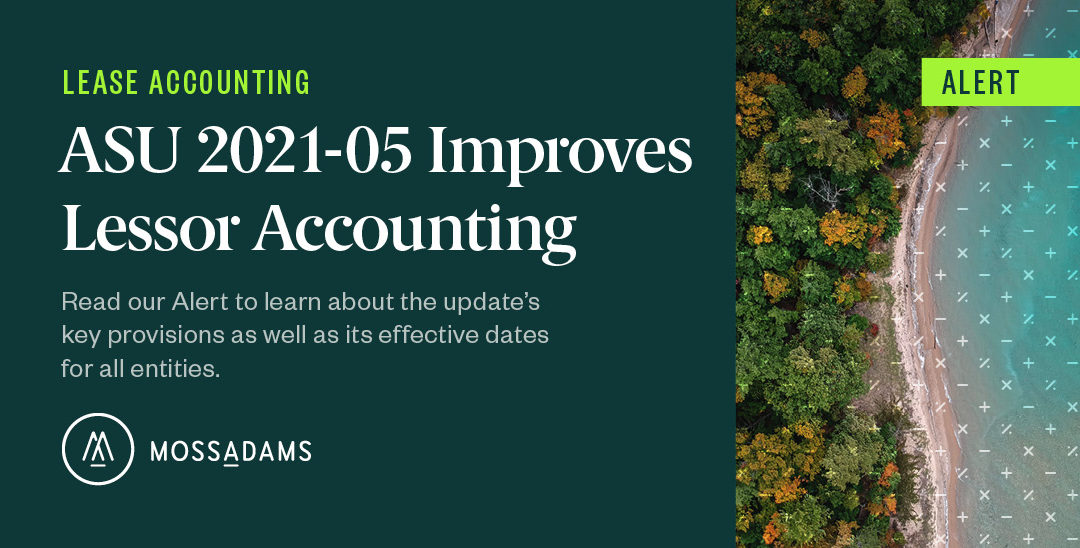This article, "Improved Lessor Accounting for Certain Leases with Variable Lease Payments," originally appeared on MossAdams.com.
On July 19, 2021, the Financial Accounting Standards Board (FASB) issued Accounting Standards Update (ASU) 2021-05, Leases (Topic 842): Lessors—Certain Leases with Variable Lease Payments.
The update is intended to improve the lease classification guidance in Topic 842, Leases, related to a lessor’s accounting for certain leases with variable lease payments.
Key Provisions
During the post-implementation review of Topic 842, the FASB received an agenda request highlighting an issue encountered by lessors: A lessor may be required to recognize a selling loss at lease commencement—also known as a day-one loss—for a sales-type lease with variable payments even if the lessor expects the arrangement will be profitable overall.
The feedback received by the FASB emphasized that this accounting outcome results in financial reporting—both at lease commencement and over the lease term—that doesn’t faithfully represent the underlying economics of lease arrangements that include a significant portion of variable payments that don’t depend on an index or a rate.
Current Guidance
Topic 842 requires a lessor to determine whether a lease should be classified as a sales-type lease or a direct-financing lease upon lease commencement based on specific classification criteria. Under the current guidance, a lessor is required to exclude variable payments that don’t depend on an index or a rate from the lease receivable. Those excluded variable payments are recognized entirely as lease income when the changes in facts and circumstances on which those variable payments are based occur.
As a result of excluding these variable payments from the lease receivable, the net investment in the lease for a sales-type lease or a direct-financing lease may be less than the carrying amount of the underlying asset derecognized at lease commencement. When the net investment is less than the carrying amount, the lessor would be required to recognize a day-one loss—regardless of whether the lease arrangement is expected to be profitable overall.
Updated Guidance
Under the amended guidance, a lessor should classify and account for a lease with variable lease payments that don’t depend on an index or a rate as an operating lease if both of the following criteria are met:
- The lease would’ve been classified as a sales-type lease or a direct-financing lease in accordance with the lease classification guidance in Topic 842.
- The lessor would’ve otherwise recognized a day-one loss.
When a lease is classified as operating, a day-one loss or gain wouldn’t be recognized because the lessor doesn’t recognize a net investment in the lease or derecognize the underlying asset.
These amendments align the lessor lease classification requirements under Topic 842 with the longstanding practice to account for certain leases with variable payments as operating leases under Topic 840.
The leased asset continues to be subject to the measurement and impairment requirements under other applicable generally accepted accounting principles.
Effective Dates
For public business entities, the amendments are effective for fiscal years beginning after December 15, 2021, including interim periods within those fiscal years.
For all other entities, the amendments are effective for fiscal years beginning after December 15, 2021, and interim periods within fiscal years beginning after December 15, 2022.
Early application is permitted.
Transition Requirements
Entities that haven’t yet adopted Topic 842 as of July 19, 2021—the date of issuance of ASU 2021-05—should follow the transition requirements in Topic 842, which requires one of the two following transition methods:
- Retrospectively to each prior period presented in the financial statements with the cumulative effect of transition recognized at the beginning of the earliest period presented
- Retrospectively to the beginning of the period of adoption with a cumulative effect of transition recognized at the beginning of the period of adoption
Entities that adopted Topic 842 prior to July 19, 2021, have the following two options to apply the amendments:
- Retrospectively to leases that commenced or were modified on or after the adoption of Topic 842
- Prospectively to leases that commence or are modified on or after the date that an entity first applies the amendments in ASU 2021-05
We’re Here to Help
For more information on how the amended guidance could affect your business, contact your Moss Adams professional.


